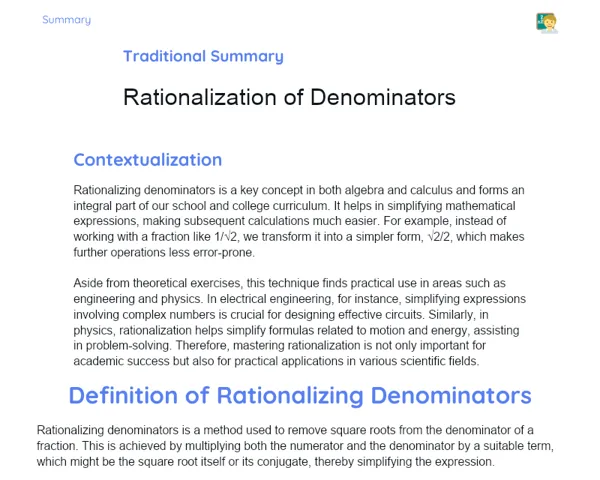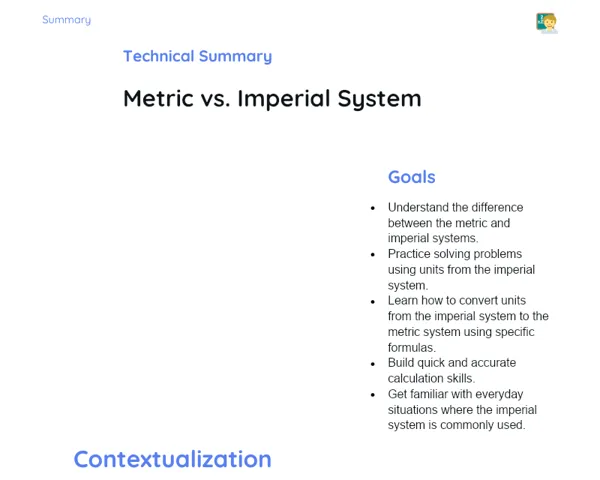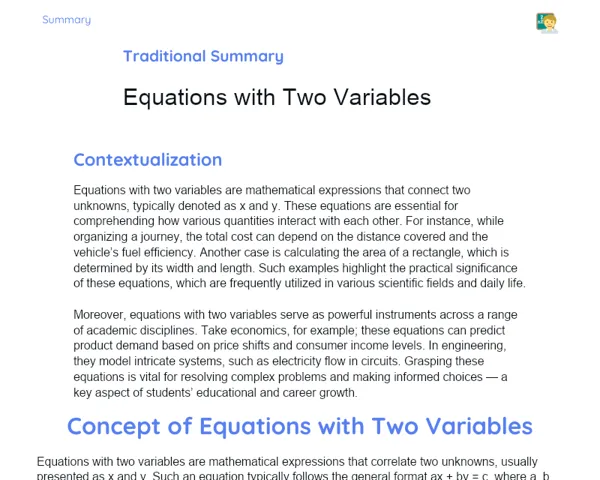Summary Tradisional | Quadrilateral: Parallelogram
Contextualization
Parallelograms form a crucial group of quadrilaterals in geometry. Defined as four-sided figures with opposite sides that run parallel, these shapes boast distinctive features that set them apart from other figures. Their properties include equal opposite sides, matching opposite angles, and diagonals that neatly cut each other in half. These traits make parallelograms very handy in practical applications, especially in fields like engineering and architecture where stability and symmetry are vital.
In our daily lives, we see parallelograms in a variety of objects and structures. Consider the rectangular screen of a smartphone, the flat surface of a table, or even certain elements of modern building designs — these are all examples of parallelograms. Grasping these properties helps in solving problems that involve measurements such as side lengths and angles, and this understanding is useful when we apply these concepts in real-life situations. In our classes, we have looked at how to identify these figures and calculate their various parameters, making the lessons both practical and engaging.
To Remember!
Definition of Parallelogram
A parallelogram is a type of quadrilateral, meaning it has four sides. What sets a parallelogram apart is that its opposite sides are parallel. This simply means that no matter how the figure is oriented, these sides will never intersect, as they maintain a constant distance apart.
Moreover, these opposite sides are equal in length. So, if you measure one side, you immediately know the measure of its opposite. This feature is very useful when calculating perimeters or tackling various geometry problems related to parallelograms.
Another key aspect is that the opposite angles in a parallelogram are equal. For instance, if one angle is 70 degrees, the angle directly across will also be 70 degrees. This helps a great deal in analysing and solving problems related to internal symmetry and unknown angle measurements.
-
Opposite sides are parallel.
-
Opposite sides are of equal length.
-
Opposite angles are equal.
Properties of Parallelograms
Parallelograms have several properties that simplify both their study and application in solving geometric problems. One major property is that their diagonals cut each other exactly in half, meaning each diagonal is equally divided at the point of intersection. This is helpful when needing to determine the lengths of the parts of the diagonal.
Another important feature is that the angles sitting next to each other in a parallelogram add up to 180 degrees. For example, if one angle is 70 degrees, the one next to it will be 110 degrees (since 180 - 70 = 110). This is particularly useful when you are calculating unknown angles in various problems.
Last but not least, the fact that opposite sides are congruent simplifies tasks such as perimeter calculations and is key in determining whether two figures are congruent — that is, if they have matching sides and angles.
-
Diagonals bisect each other.
-
Adjacent angles add up to 180 degrees.
-
Opposite sides are congruent.
Calculating Sides and Angles
To work out the sides and angles of a parallelogram, we utilise its inherent properties. If you know the length of one side, you immediately know the opposite side has the same measurement. For example, if one side is 8 cm, the side directly opposite will also be 8 cm, which makes calculating the perimeter straightforward.
Angles are determined using the facts that opposite angles are equal and that adjacent angles are supplementary. So, if one angle is known, not only is its opposite the same, but the two angles next to it must add up to 180 degrees. This method allows us to figure out all the unknown angles when at least one is provided.
The property of diagonals bisecting each other is also quite practical. Knowing that a full diagonal is split into two equal halves means that if you have a diagonal of 16 cm, each half measures 8 cm.
-
Opposite sides have the same measurement.
-
Opposite angles are equal.
-
Adjacent angles add up to 180 degrees.
-
Diagonals bisect each other.
Practical Examples and Problem Solving
In real-life scenarios, parallelograms find applications in various fields such as engineering and architecture. For example, many bridges and building frameworks employ the structure of parallelograms to enhance stability and strength. Understanding these properties helps civil engineers calculate load distributions and stress points more precisely.
In the world of art and design, parallelograms contribute to creating attractive patterns and mosaics. Their symmetrical properties lend themselves to producing visually balanced and harmonious designs. This knowledge is particularly advantageous for designers and artists working on innovative layouts.
When it comes to practical problem solving, applying the properties of parallelograms can be very effective. For instance, the area of a parallelogram can be determined by multiplying the base by the perpendicular height. Depending on the problem at hand, other related formulas might also be used.
-
Used in engineering and architecture.
-
Applied in art and design.
-
Facilitates problem-solving using specific properties.
Key Terms
-
Parallelogram: A quadrilateral with opposite sides parallel.
-
Opposite Sides: Sides of a parallelogram that are parallel and are equal in length.
-
Opposite Angles: Angles of a parallelogram that are equal.
-
Diagonals: Line segments joining opposite vertices that bisect each other.
-
Adjacent Angles: Angles sharing a common side and totaling 180 degrees.
-
Congruent: Describes sides or angles that are of equal measure.
Important Conclusions
In this lesson, we took a detailed look at parallelograms — a special type of quadrilateral where opposite sides run parallel. We delved into its essential properties like equal opposite sides and angles, supplementary adjacent angles, and the unique feature of diagonals cutting each other in half. These characteristics are fundamental in solving various geometric problems, especially those requiring precise measurements.
The real-world relevance of these topics was highlighted through practical examples, including applications in engineering, architecture, and design. Understanding the properties of parallelograms not only helps in building stable structures and creating balanced designs but also enriches our overall grasp of geometry. Students are encouraged to practise with real-life problems to further strengthen their conceptual understanding.
The insights gained from studying parallelograms extend beyond just mathematics. They provide a foundation for subjects such as analytic geometry and algebra, and even offer a spark for exploring further applications in everyday life.
Study Tips
-
Revisit the examples and exercises discussed in class to solidify your understanding of parallelogram properties.
-
Practice solving additional problems on side and angle calculations using reference books and online resources.
-
Look out for real-life applications of parallelograms in local architecture and design, and try to solve related problems to see the concepts in action.



